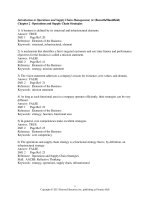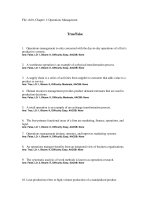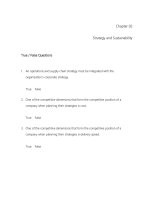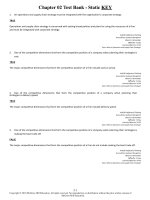Introduction to operations and supply chain management 3e bozarth chapter 09
Bạn đang xem bản rút gọn của tài liệu. Xem và tải ngay bản đầy đủ của tài liệu tại đây (928.34 KB, 46 trang )
Forecasting
Chapter 9
Chapter Objectives
Be able to:
Discuss the importance of forecasting and identify the
most appropriate type of forecasting approach, given
different forecasting situations.
Apply a variety of time series forecasting models,
including moving average, exponential smoothing, and
linear regression models.
Develop causal forecasting models using linear
regression and multiple regression.
Calculate measures of forecasting accuracy and
interpret the results.
Copyright © 2013 Pearson Education, Inc. publishing as Prentice Hall
9-2
Forecasting
Forecast – An estimate of the future level of
some variable.
Why Forecast?
Assess long-term capacity needs
Develop budgets, hiring plans, etc.
Plan production or order materials
Copyright © 2013 Pearson Education, Inc. publishing as Prentice Hall
9-3
Types of Forecasts
Demand
Firm-level
Market-level
Supply
Number of current producers and suppliers
Projected aggregate supply levels
Technological and political trends
Price
Cost of supplies and services
Market price for firm’s product or service
Copyright © 2013 Pearson Education, Inc. publishing as Prentice Hall
9-4
Laws of Forecasting
Forecasts are almost always wrong by some amount
(but they are still useful).
Forecasts for the near term tend to be more
accurate.
Forecasts for groups of products or services tend to
be more accurate.
Forecasts are no substitute for calculated values.
Copyright © 2013 Pearson Education, Inc. publishing as Prentice Hall
9-5
Forecasting Methods
Qualitative forecasting techniques – Forecasting
techniques based on intuition or informed opinion.
Used when data are scarce, not available, or
irrelevant.
Quantitative forecasting models – Forecasting
models that use measurable, historical data to
generate forecasts.
Time series and causal models
Copyright © 2013 Pearson Education, Inc. publishing as Prentice Hall
9-6
Selecting a Forecasting Method
Figure 9.2
Copyright © 2013 Pearson Education, Inc. publishing as Prentice Hall
9-7
Qualitative Forecasting Methods
Market surveys
Build-up forecasts
Life-cycle analogy method
Panel consensus forecasting
Delphi method
Copyright © 2013 Pearson Education, Inc. publishing as Prentice Hall
9-8
Quantitative Forecasting Methods
Time series forecasting models – Models that
use a series of observations in chronological
order to develop forecasts.
Causal forecasting models – Models in which
forecasts are modeled as a function of
something other than time.
Copyright © 2013 Pearson Education, Inc. publishing as Prentice Hall
9-9
Demand movement
Randomness – Unpredictable movement from one
time period to the next.
Trend – Long-term movement up or down in a time
series.
Seasonality – A repeated pattern of spikes or drops
in a time series associated with certain times of the
year.
Copyright © 2013 Pearson Education, Inc. publishing as Prentice Hall
9 - 10
Time series with randomness
Figure 9.3
Copyright © 2013 Pearson Education, Inc. publishing as Prentice Hall
9 - 11
Time series with
Trend and Seasonality
Figure 9.4
Copyright © 2013 Pearson Education, Inc. publishing as Prentice Hall
9 - 12
Last Period Model
Last Period Model - The simplest time series
model that uses demand for the current
period as a forecast for the next period.
Ft+1 = Dt
where Ft+1= forecast for the next period, t+1
and Dt = demand for the current period, t
Copyright © 2013 Pearson Education, Inc. publishing as Prentice Hall
9 - 13
Last Period Model
Table 9.3
Figure 9.5
Copyright © 2013 Pearson Education, Inc. publishing as Prentice Hall
9 - 14
Moving Average Model
Moving Average Model – A time series
forecasting model that derives a forecast by
taking an average of recent demand value.
n
D
t 1 i
Ft 1 i 1
n
Copyright © 2013 Pearson Education, Inc. publishing as Prentice Hall
9 - 15
Moving Average Model
Period
1
2
3
4
5
6
7
8
Demand
12
15
11
9
10
8
14
12
n
Ft 1
Dt 1 i
i 1
n
3-period moving average
forecast for Period 8:
=
=
(14 + 8 + 10) / 3
10.67
Copyright © 2013 Pearson Education, Inc. publishing as Prentice Hall
9 - 16
Weighted Moving Average Model
Weighted Moving Average Model – A form of
the moving average model that allows the
actual weights applied to past observations
to differ.
Copyright © 2013 Pearson Education, Inc. publishing as Prentice Hall
9 - 17
Weighted Moving Average Model
Period
1
2
3
4
5
6
7
8
Demand
12
15
11
9
10
8
14
12
3-period weighted moving
average forecast for Period 8=
[(0.5 14) + (0.3 8) + (0.2 10)] / 1
=
11.4
Copyright © 2013 Pearson Education, Inc. publishing as Prentice Hall
9 - 18
Exponential Smoothing Model
Exponential Smoothing Model – A form of the
moving average model in which the forecast for the
next period is calculated as the weighted average of
the current period’s actual value and forecast.
Copyright © 2013 Pearson Education, Inc. publishing as Prentice Hall
9 - 19
Exponential Smoothing Model
= .3
Period Demand
Forecast
1
50
40
2
46
.3 * 50 + (1-.3) * 40 = 43
3
52
.3 * 46 + (1-.3) * 43 = 43.9
4
48
.3 * 52 + (1-.3) * 43.9 = 46.33
5
47
.3 * 48 + (1-.3) * 46.33 = 46.83
6
.3 * 47 + (1-.3) * 46.83 = 46.88
Copyright © 2013 Pearson Education, Inc. publishing as Prentice Hall
9 - 20
Adjusted Exponential Smoothing
Adjusted Exponential Smoothing Model – An expanded
version of the exponential smoothing model that includes a
trend adjustment factor.
AFt+1 = Ft+1 +Tt+1
where AFt+1 = adjusted forecast for the next period
Ft+1 = unadjusted forecast for the next period = Dt + (1 – ) Ft
Tt+1 = trend factor for the next period = (Ft+1 – Ft) + (1 – )Tt
Tt = trend factor for the current period
smoothing constant for the trend adjustment factor
Copyright © 2013 Pearson Education, Inc. publishing as Prentice Hall
9 - 21
Linear Regression
Copyright © 2013 Pearson Education, Inc. publishing as Prentice Hall
9 - 22
Linear Regression
How to calculate the a and b
Copyright © 2013 Pearson Education, Inc. publishing as Prentice Hall
9 - 23
Linear Regression – Example 9.3
Copyright © 2013 Pearson Education, Inc. publishing as Prentice Hall
9 - 24
Linear Regression – Example 9.3
Copyright © 2013 Pearson Education, Inc. publishing as Prentice Hall
9 - 25









